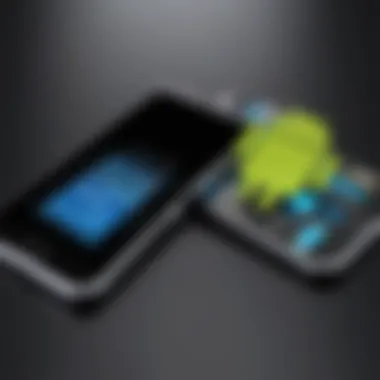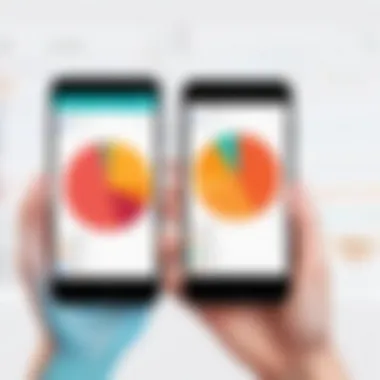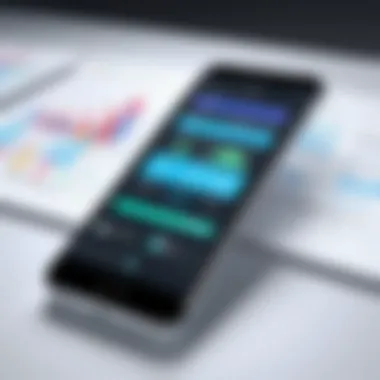Seamless Data Transfer from Android to iPhone


Intro
Switching from an Android device to an iPhone can feel like jumping from one ship to another in turbulent waters. The process often stirs up a pile of questions, chiefly about transferring data and storage. Whether it's cherished photos, vital contacts, or essential apps, getting everything to the new device is critical for a smooth transition.
This guide is designed to be your compass as you navigate this complex journey. We’ll explore various methods, tools, and techniques tailored to make your switch as seamless as possible. Understanding the nuances of data formats and compatibility can often sift through the confusion, enabling you to take full advantage of your new iPhone.
Moreover, we aim to provide thoughtful insights into the selection of appropriate methods based on your specific situation. Are you someone who frequents the tech forums or a casual user? The road to a new iPhone can be uneven, but with the right knowledge, you will be equipped to make informed choices that suit your needs.
Let’s dive into the nitty-gritty that will ensure your transition is as smooth as butter on warm toast.
Understanding Data Migration
When we talk about switching from one device to another, the word data migration comes into play. It's not simply about changing your phone; it involves taking all the personal relics, shared memories, and essential information from your Android and placing it gently into your new iPhone. Understanding this process is crucial, especially since it can make or break your entire transition experience.
What is Data Migration?
Data migration refers to the process of moving data from one storage system to another. In this case, it's about transferring everything stored on your Android phone to your shiny new iPhone. This includes contacts, messages, photos, and even apps. Essentially, if it lives on your Android device, a successful data migration entails bringing it along with you to iOS, ensuring nothing precious gets left behind.
It's worth noting that this process doesn't just involve shifting files; sometimes, it includes converting formats or adjusting settings to ensure compatibility. For instance, Android and iOS use different file systems, which can prompt challenges during migration.
Importance of Data Transfer
Data transfer is sort of like moving into a new home where everything needs to fit just right. For many, our phones are treasure troves of memories and important information, so leaving anything behind isn’t an option. Understanding the importance of transferring data accurately ensures you have a seamless transition without losing essentials like cherished photos or vital documents.
Moreover, if you’re an avid user of personal apps like Google Keep or calendars, moving that data becomes crucial for maintaining productivity. Imagine waking up and realizing your entire schedule is gone! It's a jarring thought, and that's where a solid understanding of data transfer comes in handy.
Challenges in Transferring Data
Just like navigating through a labyrinth, moving data isn’t always a walk in the park. There are several challenges that one might encounter:
- Compatibility Issues: The most common hurdle is ensuring that files from Android work well in the iOS environment. Different file systems can lead to support issues, resulting in failed transfers.
- Data Limitations: Not all data types might migrate seamlessly. For example, some custom Android app settings may not have equivalents on iOS.
- Loss of Data: In the rush to transfer, some users may lose small bits of crucial information or email settings.
- Slow Process: Depending on the amount of data, the transfer process can drag on, leading to time-consuming delays.
Understanding these challenges is the first step toward a smooth data transition. Preparation is key, as is patience. By grasping the ins and outs of data migration, users are better positioned to tackle these potential pitfalls and enjoy their new device to the fullest.
Preparing for the Transfer
Transferring your data from an Android device to an iPhone can feel like a daunting task, but preparing for the transfer is half the battle. This section focuses on the importance of proper prep work, which ultimately can save you time and headaches down the line. By understanding your needs, backing up your current device, and managing storage on your new device, you pave the way for a seamless switchover. A few key considerations include ensuring that all necessary data is accounted for and that your devices are ready for the transition.
Assess Your Data Needs
Before diving into the transfer process, it’s crucial to assess what data is essential to you. Are there specific files that you absolutely cannot live without, such as photos, contacts, or certain apps? By listing these items, you avoid a situation where you realize later that something important is missing. Think of this as packing for a trip: you’d never head off without knowing what’s crammed in your suitcase.
Additionally, consider the data types you wish to transfer:
- Contacts
- Photos and Videos
- Music and Apps (not all are directly transferable)
- Documents and Files
Each format might have its own quirks and challenges during migration. Hence, being clear about your needs right off the bat means you can choose the best transfer method tailored to your goals.
Backing Up Your Android Device
Now, backing up your Android device isn't just a precaution; it's a must-do before you make the switch. Think of it as a safety net—assuming everything goes swimmingly, you'll still have peace of mind knowing there’s a backup hanging around, just in case.


Here’s a simplified approach to backing up:
- Open the Settings on your Android device.
- Navigate to System > Backup.
- Ensure that Back up to Google Drive is activated.
- Tap on Back up now to initiate the process.
Once your data is safely stored in the cloud, you can focus on moving to your new device without the nagging fear of losing those precious selfies or vital documents.
"A stitch in time saves nine." This old saying holds true, especially when it comes to data backups.
Clearing Space on Your iPhone
Preparing your iPhone means ensuring it has enough space to accommodate your incoming data. Nothing is worse than trying to fit a square peg in a round hole.
Here are some tips to clear space:
- Delete Unused Apps: Go through your apps and eliminate ones you rarely use. They shoulder a good chunk of storage.
- Offload Photos and Videos: If you've got a treasure trove of media, consider offloading them to cloud storage or your computer, at least temporarily.
- Manage Downloads: Check your downloads folder and clean out files you no longer need. You'd be surprised at how quickly clutter accumulates.
By taking the time to manage the storage on your iPhone, you ensure that the transition is smoother and sets you up for a more organized experience right from the get-go.
With your data needs assessed, your Android device backed up, and your iPhone cleared of unnecessary bits and pieces, you're well on your way to making the transfer as seamless as possible.
Using Official Tools for Data Transfer
Transferring data from an Android device to an iPhone can often feel like navigating a maze, with each twist and turn presenting its own set of challenges. By opting for official tools, you can not only simplify the process but also boost the security and integrity of your data. These tools are specifically designed to handle the intricacies of different operating systems while ensuring that your vital information is transferred safely. Using these applications can be a game changer, providing a cohesion that manual transfer methods may lack.
Apple's Move to iOS Application
When you’re transitioning from Android to iPhone, Apple's Move to iOS app acts like a helpful guide, pointing you in the right direction. This tool allows users to securely transfer contacts, message history, camera photos, web bookmarks, mail accounts, and calendars. Essentially, it’s your digital concierge for the initial setup of your new device.
One important feature of this app is its user-friendliness. Users typically find that they can walk through the transfer process step by step, minimizing the chance of overlooking important data. All you need to do is install the app on your Android device and follow the on-screen instructions.
An important consideration is that both devices need to be connected to the same Wi-Fi network during the transfer. A simple connection error might make users hit a wall. But don’t sweat it—being patient while ensuring our devices are synchronized will pay off in the end.
Google Drive Approach
For many, relying on Google’s ecosystem is as second nature as breathing. If you're already utilizing Google Drive on your Android phone, transferring your important files can feel rather seamless. This method is especially beneficial for those who regularly backup photos, videos, and documents to Google Drive.
To begin the transfer, all one needs to do is upload relevant files from the Android device into Google Drive. Once that’s done, logging into the same Google account on the iPhone will grant you access to all those uploads.
- Key Benefits of Google Drive:
- Ease of access across multiple devices
- Automatic updates for uploaded files
- Minimal effort required for file retrieval
However, it's crucial to remember that some app data and settings won't be transferred this way. If you're counting on fully transferring specific applications or their data, this method might leave you scratching your head.
Cloud Storage Solutions
Cloud storage has become a buzzword over the past few years, heightening its relevance in data transfers. If you’re an advocate of storing your files in the cloud, solutions like Dropbox or OneDrive can also serve as effective bridges between Android and iPhone. Using these platforms, users can upload files from their Android device and then access them through the corresponding app on their iPhone.
While the idea of cloud storage is enticing, keep in mind that you must have sufficient storage space to accommodate your files. Not to mention, a solid internet connection is essential to avoid unnecessary headaches during the upload or download processes.
“Cloud storage allows you to keep your files accessible, ensuring you can manage them on the fly.”
Manual Transfer Techniques


Manual transfer methods can feel like a lost art in this digital age where everything seems to be automated. However, understanding these techniques provides significant benefits, particularly for those who relish the idea of maintaining control over their data. These methods might require a bit more elbow grease, but the pay-off is often worth the effort. By manually managing the transfer of your data, you ensure that nothing slips through the cracks.
Using a Computer
One of the most straightforward approaches to transferring data from your Android to iPhone is by utilizing a computer. This technique allows you to sidestep some of the connectivity hurdles faced during direct device-to-device transfers. To start, you’ll need a USB cable for your Android, and you’ll also need to have iTunes installed on your computer if you plan to sync certain data types with your iPhone.
Here’s a simple rundown of the process:
- Connect your Android to the computer. Open the file explorer and locate your device to access its storage.
- Copy the desired data. This may include documents, music files, and photos.
- Disconnect your Android and connect your iPhone. Open iTunes or Finder, then drag and drop the copied files from the computer to your iPhone’s storage.
This method not only allows you to preview your data but also offers you a chance to filter out what you truly need. Consider it a meticulous curation of your digital life—a process not to be rushed.
File Type Compatibility Considerations
As you embark on this manual data transfer journey, it's vital to be mindful of file types. Not every format is created equal, and understanding these nuances can save you a world of trouble. For instance, while MP3 files are compatible across both platforms, a ringtone in M4R format might rear its head as incompatible. Moreover, documents might need conversion and images might prefer certain formats akin to JPEG or PNG.
When planning your transfer, take a minute to check the following:
- Audio Files: Ensure they are in common formats like MP3 or AAC.
- Videos: Formats like MP4 and MOV are generally safe bets.
- Documents: PDFs are your best friends here, but Word documents can be tricky if not saved correctly.
This diligence in checking compatibility not only makes the transfer smoother but also saves time in troubleshooting issues later.
Transferring Photos and Videos
Photos and videos, being the most cherished digital memories, require special attention while transferring. The stakes are high because losing a memorable moment is a bummer no one wants to face. To maintain quality and ease of access, it’s worth considering both manual and software-assisted means to move your images.
Here’s how to tackle this:
- Step 1: Connect your Android device to the computer and drag and drop your photo and video files into a specific folder.
- Step 2: Once that's done, plug in your iPhone and use iTunes or Finder to sync those files directly into your Photos app.
- Step 3: If you’re worried about losing quality, consider using lossless formats like TIFF for photos where preserving detail is crucial.
By focusing on these manual transfer techniques, you maintain a meticulous grip on your data. While it may require additional effort, the control and precision in handling your personal information will undoubtedly lend to a more satisfying transition from Android to iPhone.
Data Migration Tools
When it comes to switching from an Android device to an iPhone, the role of data migration tools cannot be overstated. This section delves into different utilities designed to facilitate this transition, with a focus on their specific functions, advantages, and things to keep in mind. In today’s world, where keeping one's data intact is a bigh concern, these tools serve as the bridge between two different ecosystems, ensuring that personal information, apps, and media make it across without a hitch.
Third-Party Applications Overview
Third-party applications offer diverse features aimed at making the data transfer process smoother and more efficient. Unlike the built-in solutions provided by Apple or Google, these tools often offer unique capabilities that can cater to various user preferences and requirements. Popular options include MobileTrans, AnyTrans, and CopyTrans, each with its own set of functionalities that allow users to easily migrate data from Android to iPhone.
For instance, MobileTrans allows you to transfer not just messages and contacts, but also photos, videos, and even apps, all with a few clicks. The intuitive interface of these tools makes them appealing to tech-savvy individuals who favor control over convenience. However, users should remain vigilant about potential costs or data limitations that some of these applications may impose.
Comparative Analysis of Tools
Analyzing various tools side-by-side can help in making an informed decision. Here's a look at three popular tools:
- MobileTrans: Known for its simplicity and user-friendliness. It supports a wide range of file types and promises zero data loss. However, it’s a paid service, which may deter some users.
- AnyTrans: Offers both file management and data transfer features. Users have praised its ability to transfer app data, yet some have pointed out occasional bugs, which can be frustrating.
- CopyTrans: This tool shines in transferring music and photos. While its interface is less polished compared to others, its efficiency in handling media files makes it worthwhile for multimedia enthusiasts.
"Choosing the right data migration solution can save you time and hassle, but it's crucial to delve into each option before making a leap."
Recommendations Based on User Needs
Selecting the right data migration tool often boils down to understanding your specific needs. Here are some tailored recommendations:


- For Complete Beginners: If tech isn't your strong suit, MobileTrans offers a straightforward path with its user-friendly interface. You can concentrate on moving your data without getting bogged down by complex options.
- For Music Lovers: If your music library is your pride and joy, CopyTrans would serve in spades since it specializes in handling media files with precision.
- For Multi-Device Users: AnyTrans is perfect if you juggle between devices often. Its ability to manage files across diverse systems can be a major time-saver.
Post-Transfer Considerations
Once you have successfully moved your data from your old Android device to your new iPhone, the work isn’t quite done. This stage addresses what happens post-transfer. It's vital to ensure that data migration is not just about pulling in files, but also about making sure everything works as intended. Here’s a closer look at key elements to bear in mind after the transfer.
Verifying Data Integrity
Verifying the integrity of your data is one of the most important steps in the post-transfer process. After transferring your data, you should take a moment to ensure that nothing has gone missing. Check that contacts show the correct details, photos are not corrupted, and that apps are functioning properly. Here’s how you can do it effectively:
- Contact Check: Ensure all contacts have transferred without information loss. It’s a good idea to call or message a few to see if they connect.
- Media Inspection: Open photos and videos to confirm they are intact—sometimes, errors can lead to corrupted files during the transfer.
- App Testing: Launch your apps to make sure they operate correctly, especially ones important for work or communication.
"Data integrity is the backbone of effective communication; double-checking your data can save you headaches later."
Organizing Data on iPhone
Following verification, it’s time to organize your data. A somewhat cluttered phone can make it cumbersome to find what you need when you need it. To streamline your experience, consider:
- Folder Creation: Group similar apps together. For example, you might create folders for social media, productivity, and entertainment.
- Prioritizing Accessibility: Place frequently used apps on the home screen. It reduces the time spent searching for them.
- Setting up an Efficient Photo Gallery: Use albums in the Photos app to categorize images—this could be by events, friends, or themes, whichever makes sense for you.
Taking these steps can help cultivate a system that makes your iPhone experience more pleasant and productive.
Setting Up Applications and Accounts
The final touch after you have verified and organized your data is setting up your applications and accounts. This involves:
- Re-Logins: For security reasons, many apps will require you to sign in again. Have your credentials handy to make this process smoother.
- Notification Settings: Review the notification preferences for each app. Tailoring these can help you stay focused, particularly when it comes to work-related apps versus leisure ones.
- Syncing Accounts: Ensure your email accounts, cloud services, and social media accounts are synced properly to get the most out of your device.
Ultimately, getting your apps in order not only enhances usability but is also a means to enhance security and efficiency as you explore the capabilities of your new iPhone.
Questions and Answerss about Data Transfer
When it comes to migrating data from Android to iPhone, questions and uncertainties are common. The landscape of device compatibility and data management can be a bit daunting. This section tackles the tough questions that often arise during the data transfer process, offering clarity and guidance. By providing answers to common inquiries, individuals can approach their migration journey with confidence, minimizing the chances of hiccups along the way.
Common Queries and Solutions
In the quest for a smooth transition, several queries frequently pop up for users. Here are some of the key questions:
- Can all my apps transfer?
Not every app may have direct compatibility between the two platforms. Many applications, especially games or those requiring specific OS functions, remain confined to their original ecosystems. - What formats will my photos and videos need to be?
Typically, standard formats like JPEG for photos and MP4 for videos are universally accepted. However, be aware of any proprietary formats that certain apps may use. - Is my SMS history transferrable?
While messages tend to be a tricky area, some third-party solutions or built-in apps might have provisions for this. Knowing the specifics will save a lot of frustration.
Having clear answers to these queries can streamline preparation and prevent unexpected delays during the transition.
Troubleshooting Transfer Issues
Despite careful planning, issues may arise during the migration process. Here are some common problems and their solutions:
- Connection problems:
If your devices aren’t connecting, ensure that they are both using the latest firmware and that your Wi-Fi settings allow for transfers. Dual-checking your networks can eliminate some common headaches. - Data not appearing:
If data doesn’t transfer as intended, verify your settings. Sometimes, permissions must be explicitly allowed, or the transfer tool may need to be restarted. Patience is essential. - Incompatibility errors:
Certain data types might not be supported on your new iPhone. In these cases, you might want to consider converting files to the required format before proceeding with the transfer.
Tackling these potential roadblocks with a proactive approach will help simplify the overall experience.
Best Practices for Future Transfers
Thinking ahead can save users time and effort in future data transfers. Here are several recommendations:
- Regular Backups:
Make backing up data a habit. Use cloud services or local storage backups to ensure all your vital information remains secure and easily accessible. - Keep Device Updated:
New updates come with improvements that could enhance the transfer process. Always keep both devices' operating systems current. - Stay Organized:
Maintaining an organized file structure on your Android will streamline the transfer. Understanding where your important files reside will be beneficial when selecting what to migrate. - Research Tools:
Stay updated on the latest data transfer tools available in the market. Read reviews from communities like Reddit for genuine feedback and experiences.
By adhering to these best practices, users can ensure a more effective and less stressful process next time.
Remember: Data migration is more than just a technical endeavor— it's about maintaining access to your cherished memories and important information. Plan accordingly.



